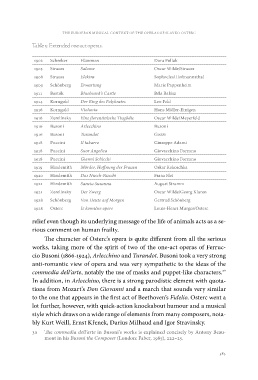Page 385 - Weiss, Jernej, ur. 2019. Vloga nacionalnih opernih gledališč v 20. in 21. stoletju - The Role of National Opera Houses in the 20th and 21st Centuries. Koper/Ljubljana: Založba Univerze na Primorskem in Festival Ljubljana. Studia musicologica Labacensia, 3
P. 385
the european musical context of the oper as of slavko osterc
Table 3: Extended one-act operas.
1902 Schreker Flammen Dora Pollak
1905 Strauss Salome Oscar Wilde/Strauss
1908 Strauss Elektra Sophocles/Hofmannsthal
1909 Schönberg Erwartung Marie Pappenheim
1911 Bartók Bluebeard’s Castle Béla Balász
1914 Korngold Der Ring des Polykrates Leo Feld
1916 Korngold Violanta Hans Müller-Einigen
1916 Zemlinsky Eine florentinische Tragödie Oscar Wilde/Meyerfeld
1916 Busoni Arlecchino Busoni
1916 Busoni Turandot Gozzi
1918 Puccini Il tabarro Giuseppe Adami
1918 Puccini Suor Angelica Giovacchino Forzano
1918 Puccini Gianni Schicchi Giovacchino Forzano
1919 Hindemith Mörder, Hoffnung der Frauen Oskar Kokoschka
1920 Hindemith Das Nusch-Nuschi Franz Blei
1921 Hindemith Sancta Susanna August Stramm
1921 Zemlinsky Der Zwerg Oscar Wilde/Georg Klaren
1928 Schönberg Von Heute auf Morgen Gertrud Schönberg
1928 Osterc Iz komične opere Louis-Henri Murger/Osterc
relief even though its underlying message of the life of animals acts as a se-
rious comment on human frailty.
The character of Osterc’s opera is quite different from all the serious
works, taking more of the spirit of two of the one-act operas of Ferruc-
cio Busoni (1866-1924), Arlecchino and Turandot. Busoni took a very strong
anti-romantic view of opera and was very sympathetic to the ideas of the
commedia dell’arte, notably the use of masks and puppet-like characters.30
In addition, in Arlecchino, there is a strong parodistic element with quota-
tions from Mozart’s Don Giovanni and a march that sounds very similar
to the one that appears in the first act of Beethoven’s Fidelio. Osterc went a
lot further, however, with quick-action knockabout humour and a musical
style which draws on a wide range of elements from many composers, nota-
bly Kurt Weill, Ernst Křenek, Darius Milhaud and Igor Stravinsky.
30 The commedia dell’arte in Busoni’s works is explained concisely by Antony Beau-
mont in his Busoni the Composer (London: Faber, 1985), 222–25.
383
Table 3: Extended one-act operas.
1902 Schreker Flammen Dora Pollak
1905 Strauss Salome Oscar Wilde/Strauss
1908 Strauss Elektra Sophocles/Hofmannsthal
1909 Schönberg Erwartung Marie Pappenheim
1911 Bartók Bluebeard’s Castle Béla Balász
1914 Korngold Der Ring des Polykrates Leo Feld
1916 Korngold Violanta Hans Müller-Einigen
1916 Zemlinsky Eine florentinische Tragödie Oscar Wilde/Meyerfeld
1916 Busoni Arlecchino Busoni
1916 Busoni Turandot Gozzi
1918 Puccini Il tabarro Giuseppe Adami
1918 Puccini Suor Angelica Giovacchino Forzano
1918 Puccini Gianni Schicchi Giovacchino Forzano
1919 Hindemith Mörder, Hoffnung der Frauen Oskar Kokoschka
1920 Hindemith Das Nusch-Nuschi Franz Blei
1921 Hindemith Sancta Susanna August Stramm
1921 Zemlinsky Der Zwerg Oscar Wilde/Georg Klaren
1928 Schönberg Von Heute auf Morgen Gertrud Schönberg
1928 Osterc Iz komične opere Louis-Henri Murger/Osterc
relief even though its underlying message of the life of animals acts as a se-
rious comment on human frailty.
The character of Osterc’s opera is quite different from all the serious
works, taking more of the spirit of two of the one-act operas of Ferruc-
cio Busoni (1866-1924), Arlecchino and Turandot. Busoni took a very strong
anti-romantic view of opera and was very sympathetic to the ideas of the
commedia dell’arte, notably the use of masks and puppet-like characters.30
In addition, in Arlecchino, there is a strong parodistic element with quota-
tions from Mozart’s Don Giovanni and a march that sounds very similar
to the one that appears in the first act of Beethoven’s Fidelio. Osterc went a
lot further, however, with quick-action knockabout humour and a musical
style which draws on a wide range of elements from many composers, nota-
bly Kurt Weill, Ernst Křenek, Darius Milhaud and Igor Stravinsky.
30 The commedia dell’arte in Busoni’s works is explained concisely by Antony Beau-
mont in his Busoni the Composer (London: Faber, 1985), 222–25.
383


